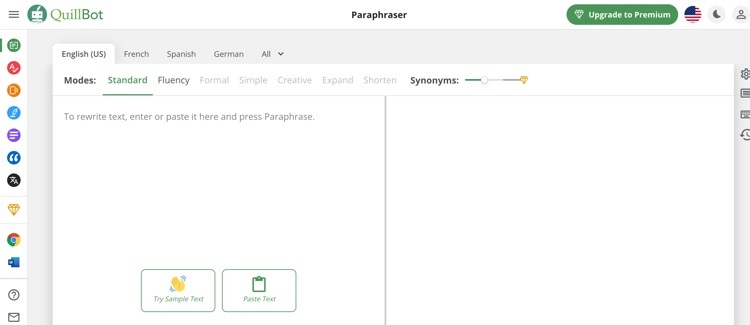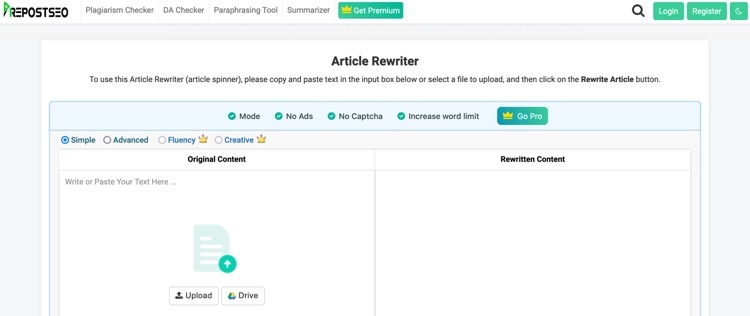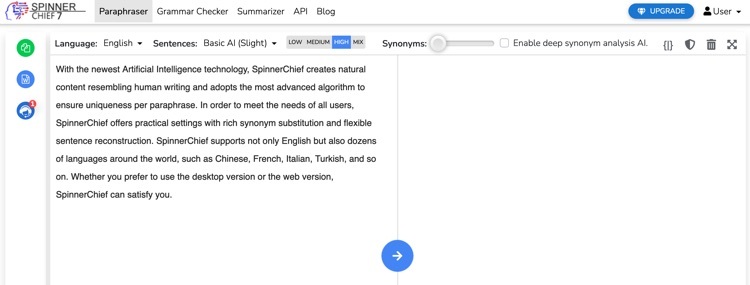An AI article rewriter enables you for example to efficiently repurpose long-form written content (like blog posts) into unique articles that can be published on other platforms like:
By doing so, you:
- Get in front of brand new audiences who may otherwise never come across you
- Build search visibility with additional placements in the rankings for important keywords
- Generate new leads and customers (such as by linking to landing pages)
There are a number of AI article rewriter tools available—it can be hard to know where to start!
In this post, we:
- Explore the top 9 AI article rewriter tools currently available
- Review their suitability for repurposing long-form written content for publication elsewhere.
But first, just so we're all on the same page...
What Is an AI Article Rewriter?
An AI article rewriter does exactly what you might expect.
It takes an article, such as a blog post, and uses artificial intelligence to reformulate or rephrase the content.
The end result should be a piece of content that differs enough from the original to be considered unique.
One of the main advantages, as explored in more detail below, is that you can take your original content, and repurpose it as brand new, unique content that gives you additional search engine visibility.
Let’s dive into that some more…
Why Use an AI Article Rewriter for Content Repurposing?
Let’s first clarify why you need to rewrite articles as part of a content repurposing workflow in the first place.
Let’s say you have a blog, which you (if you’re doing it right) publish content on regularly and consistently.
Great!
But by leaving the content just on your blog—i.e. without any repurposing—you’re only achieving a fraction of the benefit you otherwise could by simply adapting that content for different environments and audiences.
By not repurposing your blog content, you're only achieving a fraction of the benefits you could by adapting it for publication elsewhere.Click To Post OnSo you repurpose it into different forms (if you’re unsure how, here are 21 ways to do so!), publish it elsewhere, and multiply the benefits.
That includes things like repurposing it into video, social media posts, and articles to be published elsewhere, such as:
- Medium…
- An article on LinkedIn…
- Third-party blogs as a guest post, such as for SEO benefits and exposure to larger audiences than your own.
It’s in creating these articles to be published elsewhere that AI-powered article rewriters become really useful.
Now, just in case you’re wondering, for some of these, yes, you could at least just copy your post, paste it elsewhere, and be done.
But… and it’s quite a big but…
Doing so isn’t very effective, and could even be damaging!
Don't just copy and paste your blog posts onto other platforms. Rewrite them with AI article rewriter tools — unique content gets more search visibility.Click To Post OnHere’s why…
- Your content will only appear once on Google—it will pick what it deems to be the most authoritative instance of your article, use that in the SERPs, and other places where the same content appears will be, for all intents and purposes, ignored…
- Google may pick somewhere other than your website as the most authoritative source. The most benefits come from traffic you attract to your own website. You can do things like capture leads more effectively than elsewhere, add tracking pixels, have visitors browse other pages on your site, gain more familiarity with your brand, and a lot more. So not rewriting the content and taking the lazy option means you give much of the benefit of your content to some other business at the expense of your own…
In addition, long-form content to the tune of 2,000-3,000 words plus is fine and usually a positive for your business’s blog.
But this is usually too long for sites like Medium and LinkedIn’s publishing platform, where articles under the 1,000 word mark tend to perform more strongly with audiences.
So, unless you’re publishing blog posts of around that length anyway, a copy-and-paste job for many businesses just wouldn’t work.
So what should you do?
When republishing blog content onto other platforms, rewrite it first (try using AI article rewriter tools). This keeps your content unique while building search visibility.Click To Post OnBy instead rewriting the content for other websites, you…
- Enjoy multiple listings on Google and other search engines for a fraction of the effort it took to create the original content (in other words, multiply your search engine visibility)…
- Enhance the authority of your website, whether directly or indirectly, with inbound links from unique (i.e. rewritten) content you’ve published elsewhere…
- Create content with the right length to maximize engagement on the site in question.
And you can either do this manually, which, let’s face it, probably just won’t get done, because it can be…
- Laborious…
- Time consuming (even if less so than creating the original post)...
- And the necessary resources are nearly always focused on getting the next piece of original content out the door
OR…
You can use a suitable tool to help, namely an AI-powered article rewriter, to speed up the process no end (and even make it fun!), giving you all the benefits but without the headaches and hassles, and making the whole process (if you select the right tool) a breeze in comparison.
An AI article rewriter tool can be a useful part of your content repurposing workflow. Repurpose blog posts into unique content for publication elsewhere.Click To Post OnWhich is exactly what this post is all about!
So…
What Does An Effective AI Article Rewriter Tool Look Like, When It Comes to Content Repurposing?
Let’s be really clear.
The purpose behind using an AI-powered article rewriter for content repurposing is to speed up (and make a lot easier) what would otherwise be a laborious task.
The benefits without the hassles, correct?
With that in mind, the criteria used for testing the various tools available were simple.
Namely, can it effectively rewrite a paragraph (or more!) of text so that:
- The meaning is retained?…
- The content is rewritten without the addition of new, potentially unwanted and/or inaccurate information (which can get really annoying!)...
- It isn’t just swapping words in each sentence with synonyms (which can sound really clunky and artificial!) or just moving words around (which won’t make it unique enough when it comes to SEO)…
- The result is easy to read, doesn’t sound artificially-generated, and reads as if a quality human writer had written it!
If the tool can take a few paragraphs of text, such as a whole section of an article or blog post, and return quality rewritten content, without sticking too rigidly to the original paragraph definitions, then even better.
Above all, for a business intending to add article rewriting into their content repurposing workflow, the main question to ask is this…
Is the end result something that could be posted on say Medium or LinkedIn’s publishing platform and leave the reader with a positive impression?
Tough call? Maybe.
We’ve researched the top 9 AI article rewriter tools currently available, so let’s put them through their paces and see what they’re capable of.
Is it all just hype? Is the output mostly unpublishable garbage that you’d prefer not have associated with your business?
Or do they actually create content you can be proud of to help grow your online visibility, and all in a fraction of the time it would take to do manually?
They will all be reviewed here—for most of them, a free trial or free version of the software was used for the testing, similar to any prospective customer—and then a recommendation made on what are considered to be the top choices available for repurposing written content into unique articles for publication elsewhere.
Let’s start taking a look…
NOTE: The pricing info supplied in this post was correct at the time of writing, but is of course subject to change at any time.
The Top 9 AI Article Rewriters
1. Jasper

Jasper is one of the most respected tools available for writing AI-generated content, including rewriting articles. They claim you can train it in your voice, so it should still sound like the rest of your content—exactly what you want when it comes to repurposing written content. There’s also a useful extension for Chrome that means you have easy access to the software when on other websites.
How It Performed
It was hard to see how to use Jasper to rewrite existing content. It’s all designed to create content from scratch.
But after looking through their templates, a Content Rewriter option was found (in beta at the time of writing).
Clicking on that, you can enter up to 2500 words to be rewritten at a time (so probably not ideal for a full blog post or article).
You’re then asked to enter in your rewriting goal. This was set to, “To turn it into unique content and reduce the size by about half”.
The Tone of voice was set to Similar to the original.
On clicking Generate, a couple of rewritten options were then produced, within just a few seconds.
Both read well, were of excellent quality and were sufficiently different from the original to likely be listed as separate, unique content in the SERPs.
However, the drawback is that it’s not designed at present to repurpose a whole blog post or article at a time, so you would need to copy and paste back and forth which is less than ideal, and not that different to using ChatGPT (which is also reviewed below).
Pricing
- 7-day free trial (credit card required)
- Plans start at $49 per month, or $468 per year for an annual subscription
2. QuillBot

QuillBot bills itself as a “paraphrasing tool”, which essentially works by swapping in synonyms and rephrasing sentences. Its premium modes however offer enhanced creativity, the ability to shorten text (potentially useful for repurposing), and other features. It also provides plugins for Chrome and Microsoft Word, making it an easily accessible piece of software.
How It Performed
They have two potential tools available for article rewriting, a Paraphraser and a Summarizer.
Using the Paraphraser tool first, the result read reasonably well and was reasonably different to the original. Some bits would need adjusting, such as where it read a little awkwardly or swapped in inappropriate phrasing or synonyms (for example, “in this guide” was changed to “in this book”).
Overall though, quite good, and the result may well be improved by using one of their premium options.
For testing the Summarizer tool, the Summary length was set to Long so that the result was a bit shorter but not overly so.
The result (which was about a third shorter than the original) started off well, but the last half of it was virtually identical to the original. So it’s less suitable for creating unique content suitable for publishing elsewhere.
So overall, the Paraphraser tool would be the one to use, and the output reasonable. It wasn’t amazing, but would still save quite a bit of time when repurposing an article.
Pricing
QuillBot has a couple of free modes available, with certain limitations, and five paid premium modes if you want to unlock more sophisticated capabilities.
- Quillbot has a free level available that doesn’t require registration, for which you can rewrite content based on one of their two free paraphrasing modes
- Registration provides largely the same functionality but gives you access to the proper interface for the software
- The paid premium version, at $19.95/month or $99.95 annually, unlocks other writing modes, unlimited words, a plagiarism checker, and more.
3. WordAi

WordAI is an AI-powered tool that uses the latest advancements in Natural Language Processing (NLP) to rewrite articles and other content into human-quality, unique content. Rather than just swapping in synonyms, it purports to understand the meaning behind sentences, allowing it to restructure them while maintaining the original intent and ensuring it reads in a completely natural way.
How It Performed
As soon as I signed up via the 3-day free trial, a button appeared that said Take Me to Rewrite Articles. So far, so good!
The rewriting interface has a text editor on the left- and right-hand side, and you simply enter your text on the left. There’s a dropdown that lets you specify the number of rewrites you want, and a scale that lets you change it from the default Regular setting to either More Conservative or More Adventurous.
For the test, I left it set to Regular, and a single rewrite.
The output was very high quality, with a uniqueness level (provided by the software) of 87%. However, in reading it through there were still too many similarities with the original, and I wouldn’t have much confidence in it being able to achieve an additional search engine listing.
So, switching up to the More Adventurous option, I tried again. This time the uniqueness level was 96%, and the output was again very high quality.
Visually, there were still a lot of similarities, but these are likely to be mitigated in practice by:
- Adjusting the output here and there…
- Moving paragraphs and sections around manually where possible (for example, the order of items in listicles and bullet points can usually be moved around easily).
The software even comes with a button you can click to highlight phrases that are the same as the original, making things easier to adjust.
After testing with an initial few paragraphs, a whole blog post was then pasted into the tool to be rewritten. It took longer to process, as expected, but was still done in around 20 seconds, seemingly accomplishing the task with ease.
The output was again very high quality, but would need some polishing here and there, as well as moving bits of content around where possible to ensure the end result was fully unique.
So overall, a very positive experience that provides high quality rewritten content that, after a few manual changes as well, I’d have a lot of confidence in publishing elsewhere and achieving additional search engine listings as a result.
Still some manual effort involved, but it’s easily delegated or outsourced, and an end result that would take a fraction of the time it would otherwise take to achieve without the software.
Despite all the positives, the main limitation however was that there is seemingly no way to ask it to condense the content down if the original is a few thousand words long.
So for example you wouldn’t be able to reduce a 2,000-3,000 word blog post into a 1,000 word article for publication elsewhere.
If your blog posts are already shorter though, the tool is likely to prove very valuable.
Pricing
- WordAI provide a 3-day free trial
- Pricing is then at $57 per month, or a $324 annual subscription
4. Pre Post SEO

Pre Post SEO’s AI article rewriter is a powerful tool that uses a variety of techniques to rewrite text, including synonym replacement, sentence restructuring and paraphrasing. Using it involves simply pasting in your text, selecting the desired style, and clicking the Rewrite Article button. Free to use, it also has a couple of premium modes available.
How It Performed
Rewriting an article is as simple as pasting it into the left-hand side of the software, and waiting for the rewritten version to appear on the right.
I started off with the Simple option. The result had a few words swapped out for synonyms and the odd bit of rephrasing, but was otherwise very similar to the original and wouldn’t pass for unique content in terms of the SERPs.
Moving onto the Advanced option, the result was very similar (with changes such as “we’ve seen” being adjusted to “we have seen”—yep!...). There were even some typo/word spacing issues in the output (such as “newchannel” rather than “new channel”.
I also tried their paraphrasing tool, and the result was much the same.
Their Fluency or Creative paid options may have performed better, but the results of our initial test didn’t give much confidence or reason to want to do that.
Pricing
- You can use a restricted version of the tool for free and without needing to register, though you have to keep clearing a recaptcha box to be able to use it
- Paid options start at $10 per month, or an annual subscription at $50
5. AISEO

AISEO is one of the newer tools available, and has a variety of features available, including for rewriting pre-existing articles and other content. You can also paste in the URL of a post and have it import the content. There are a number of writing goals available, such as the ability to shorten content, potentially useful when repurposing blog posts for other platforms. It also has a Chrome extension available.
How It Performed
The basic process of rewriting some content was straightforward and easy. You paste in the content you want to be rewritten on the left, with the output appearing on the right, which happens within just a few seconds.
The output was of a reasonable quality too. It worked on a paragraph-by-paragraph basis, reworking each paragraph (including changing the number of sentences on occasion), rephrasing things and using suitable synonyms.
Occasionally the phrasing sounded a little awkward and may need tweaking, but overall a positive result. The output also gives you a level of uniqueness, which for our test was rated at 85%.
Their free account level was used for the test, for which the word count of the output is roughly the same as the input, but it would be interesting to test their text shortening capability which is available for paid users.
Pricing
- Free accounts are available and have a 125 word limitation
- Paid plans start at $19 per month, or an annual plan starting at $180
6. SpinnerChief

Although the use of ‘spinner’ in its name has some unfortunate blackhat SEO-type connotations that can deter more serious business users, the tool actually has a number of features that on the face of it appear comparable to similar tools that we’re reviewing here. It also appears to integrate in some way with ChatGPT, with a ChatGPT rewrite capability. There’s a web-based and a downloadable desktop version of the software.
How It Performed
In testing, the article rewriter tool appears to work on a sentence by sentence basis, moving clauses within a sentence around and then using synonyms and alternative phrases for some of the content to make it unique.
However, it doesn’t appear to then understand the meaning of the new sentences it creates, so some of the output can prove problematic.
For example, on testing with a previous blog post about Reddit, one of the new sentences created claimed that Reddit’s user base consisted of its subreddits, which didn’t make sense.
It’s possible that the ChatGPT rewrite functionality helps resolve some of this, but this wasn’t possible to test with the free version of their software.
Pricing
- You can use SpinnerChief for free for up to 20 ‘spins’ a day, and up to 10 paragraphs at a time
- Pricing is heavily swayed towards incentivizing users to purchase either yearly, or preferably, lifetime access, with lifetime starting at just $122, in contrast to monthly pricing starting at $22/month. Make of that what you will, but perhaps suggests a problem in retaining customers on one of their recurring plans.
7. ChatGPT Plus

Launched in November 2022, and reaching 100 million active monthly users within just a couple of months, ChatGPT saw the fastest adoption of any software in history. While it can be used for free, ChatGPT Plus provides access to GPT-4, an AI model that’s more advanced for things like article rewriting, and which I used for this review. It can potentially be used as an AI article rewriter, as long as you’re prepared to issue a number of prompts to do so.
How It Performed
The main issue with using ChatGPT as an article rewriter is the need to input multiple prompts, as the length of the prompt is restricted.
This means selecting a few paragraphs at a time, along with a basic prompt such as, ‘Rewrite the following so it’s around 50% of the current length’, depending on what your goals are.
From the output, which was outstanding, it was clear that the AI understood the meaning of the paragraphs supplied, and would only need a tweak here and there to make it suitable for publication.
Overall, it saves a lot of time versus doing it manually and the output quality is very high, but the main disadvantage is the process of feeding in a few paragraphs at a time is more painful than other tools and not too practical for long-term use.
Pricing
- ChatGPT is free to use
- ChatGPT Plus is available for $20 per month.
8. Wordtune

On the face of it, Wordtune feels like it’s been designed more specifically as a rewriter tool, with even the button for their front page tool using the text, Rewrite. As well as helping rewrite longer content like articles, it helps writers express more clearly what they intend to say. You can also use the software to shorten down text, useful when repurposing longer blog articles for other platforms. An add-in for Microsoft Word is available.
How It Performed
To use the tool, essentially you paste in the text you want to rewrite, including a whole article if needed, highlight the text you want to rewrite, and then click the Rewrite button. In the free version, you then go through each sentence in turn, picking one of the rewritten variations provided.
Their premium version allows you to do this paragraph-by-paragraph instead, to help speed things up.
The rewrites were very good quality, though when it comes to using the software for content repurposing:
- The process felt time consuming…
- More importantly, it quickly became clear that the software is not designed to create unique content based on your input, but to improve the quality of the writing.
In all, great tool for what it’s designed to do, but not really suitable for rewriting existing articles into unique content.
Pricing
- You can use Wordtune for free, with up to 10 sentence rewrites a day…
- Its premium version starts at $24.99/month or around $120 for a year’s access.
9. Copy.ai

Copy.ai is a sophisticated content writing tool that uses AI to help do things like write blog post, sales copy and social media content. For rewriting, its editor can help rewrite paragraphs and polish sentences but, like Wordtune above, it looks at first glance to be less suitable for rewriting articles into brand new pieces for content repurposing. But let’s take a look and see how it performs in practice.
How It Performed
Copy.ai has multiple rewriting tools available, such as the ability to rewrite content with keywords, change the tone of a piece of writing, and a sentence rewriter.
However, there were none that appeared to do what was needed when it came to rewriting a longer article.
For example, doing so sentence by sentence would be impractical, and changing the tone wouldn’t do what was required.
In addition, the tool works by providing a range of options for a particular sentence or paragraph, and you then copy and paste it into their editor.
So again, it’s another great tool for what it’s designed to do—improving copy and help with idea generation—but not really suitable as an AI article rewriter for content repurposing.
Pricing
- The free plan gives you 2,000 words per month
- Pricing starts at $49/month, or a yearly plan at $432
Top Recommendations
In the end, each of the tools listed above had one limitation or another, whether it was low quality output, general unsuitability for repurposing long-form written content, an inability to input a whole article or blog post, or something else.
The top recommendation would have to be WordAi, which is distinct in its ability to both of the following:
- Accept a long-form article as input—it can accept thousands of words at a time, which other tools cannot…
- Provide high quality, unique output.
Other tools on the list, such as Jasper and ChatGPT Plus, can do the latter and do so admirably, but involve lots of copying and pasting to get a full post or article rewritten, and so aren’t ideal.
WordAI makes things a lot easier from that perspective, but still has the limitation that, if you regularly produce blog posts that are a few thousand words long, you can’t condense them down into shorter articles.
So as things stand, while these tools can certainly help and save a lot of time, for now at least, rewriting a blog post or article as part of your content repurposing workflow will for many of us still require some manual activity too.
Frequently Asked Questions
What is an AI article rewriter?
An AI article rewriter uses artificial intelligence to reformulate or rephrase written content to create unique articles for publication elsewhere.
Why use an AI article rewriter for content repurposing?
By rewriting articles, you can create unique content to expand search visibility, attract new audiences, and repurpose existing content effectively.
How can an AI article rewriter tool benefit my content repurposing workflow?
An AI article rewriter tool can speed up the process of creating unique articles, enhance search engine visibility, and help you adapt content for different platforms efficiently.
To Conclude
As we’ve seen, all of the tools reviewed here have limitations of one kind or another when it comes to rewriting long-form articles for publication elsewhere.
Our clear winner is WordAI, which makes the process a breeze, but even this software is still limited if you need to condense down a multi-thousand word blog post into a shorter piece for publication elsewhere.



